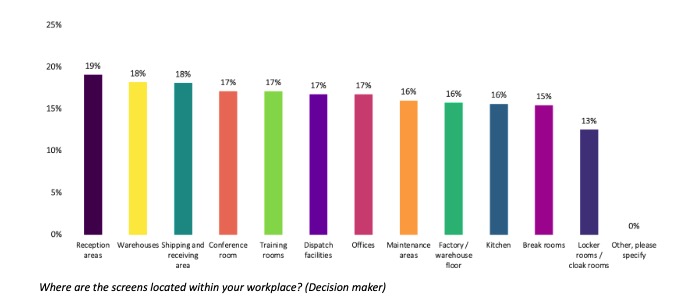
Workplace Communications Clearly Improved When Digital Signage Deployed: New Research
January 25, 2024 by Dave Haynes
Google’s Chrome OS team and UK-based CMS software firm ScreenCloud have jointly released findings from extensive survey research about using digital signage for workplace communications, with the crowd confirming digital signage significantly improves employee engagement, motivation and performance.
The survey done in Q4 2023 simultaneously polled both decision-makers and employees from larger manufacturing, logistics, transportation and supply chain organizations – industries that have largely deskless workforces. There were 2,400 total respondents, equally split between these sectors as well as between decision-makers and employees.
The results are packaged up in a report: ‘The State of Digital Signage: 2023-2024.” I got a preview copy, and the full report is targeted for release next week during ISE.
The report breaks down into chapters and includes some upfront conclusions labeled as the good, the bad, and the ugly:
The Good:
Generally, when properly implemented, the consensus is clear – digital signage works. The technology is liked by both deskless employees and decision-makers alike, boosting productivity, engagement, data accessibility and more across diverse companies. In short, the products elicit the desired impacts.
Key Stats:
- 79% of all respondents said their perception of workplace screens was positive.
- 59% of workers said the information shared on workplace screens helps them become more productive.
- 84% of decision-makers stated the screens positively engage staff, with 43% citing a significant uplift.
- 61% of employees feel the communications foster greater business alignment.
The Bad:
Alarmingly, practically every company using digital signage has faced cultural, technical and vendor issues during rollout and throughout continuous usage. Businesses overwhelmingly feel they lack adequate support from vendors when implementing the technology. This clearly signals an industry maturation need – ensuring businesses have access to the necessary expertise and guidance to assist them in leveraging the full potential of the technology in order to achieve business objectives.
However, the trajectory is positive. Vendors recognize these challenges and are already working to simplify processes moving forward. Despite troubles, IT continues adopting signage while staff and leadership remain fond of the technology’s promise. There are fixable problems, and progress is happening.
Key stats:
- 100% of companies faced cultural, technical and vendor problems with their signage strategy.
- 86% claim to have an implementation process, yet 41% of decision-makers don’t actually know what it is.
- 42% wanted more vendor support time, 40% took issue with limited consultation around implementation.
Related to that, all decision-makers encountered at least one technical difficulty, whether remote management, scalability, network connectivity, integration with other systems or otherwise.
The Ugly:
Several troubling cultural elements must still be overcome for digital signage’s success to fully take hold. A concerning portion of decision-makers with existing signage lack processes to guide implementation or don’t understand their own workflows. This suggests deployments can happen haphazardly, unable to drive outcomes.
More worrying are the employee-level cultural challenges. While six in ten workers responded positively to digital signage across several metrics like data literacy, productivity and engagement, the other 40% seem harder to win over. Asked about internal cultural barriers, 24% of decision makers pointed to preferences for other communication channels like WhatsApp, which has significant risks of misinformation and miscommunication. Another 24% cited change resistance and privacy concerns. Similarly high numbers (23%) highlighted change adaptation troubles, training deficiencies and uncertainty around content.
Organizations seeking better employee engagement via signage face significant adoption barriers if there are sizable employee segments resistant to the technology’s rollout. Shifting long-held opinions can take significant time and effort. However, by identifying primary barriers and engaging with experts, tailored strategies can be developed to counter cultural opposition through enhanced change management. This facilitates broader adoption by addressing core disconnects between end-users and technology. Ultimately, this will empower them to advance progress against organizational goals around productivity.
Key stats:
- 100% of companies faced cultural difficulties adopting digital signage, per decision makers.
- Top challenges were preferences for email/notice boards (24%), privacy issues (24%), and resistance to change (24%).
- Troublingly, 41% of Decision makers said they have screen number/location processes for maximum impact but struggled to articulate them.
- 14% admitted having no process at all, despite using the tech already.

“Deskless workers make up around 80% of the global workforce, so when we consider that these individuals do not feel that they receive the communication and opportunities afforded to their information worker counterparts, it’s no wonder that organisations are struggling with a disengaged workforce and therefore decreased productivity,” says Mark McDermott, CEO of ScreenCloud.
“Our research outlines that 78% of deskless workers do not have access to a company email address and 72% do not have access to a company intranet,” he adds. “Despite this, we often see organisations attempting to use these channels – and other platforms used to communicate with information workers – to connect with their frontline workforce. Not recognising the tech equity gap disadvantages deskless workers, creating a barrier to them becoming more engaged, more data-driven and more compliant with health and safety protocols. Everyone on the frontline deserves a more equitable technological experience, which digital signage can go some way to balancing.”
“This research underscores the immense potential of digital signage to bridge communication gaps, improve productivity, and enhance the overall well-being of deskless workers,” adds Filipe Ho, Global Strategic Partnerships Lead at Google. “In today’s world it’s imperative that every worker, from head office to plant floor, has the right information at the right time to perform in their roles. For organisations that want to better connect with their employees and unlock the full potential of their workforce, they should consider the importance of communication channels, as well as how that information is formatted, designed, and shared.”




Leave a comment